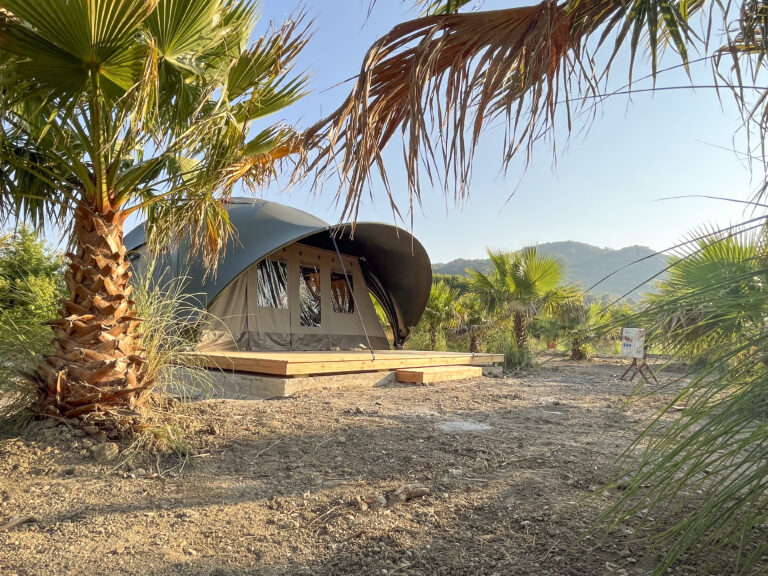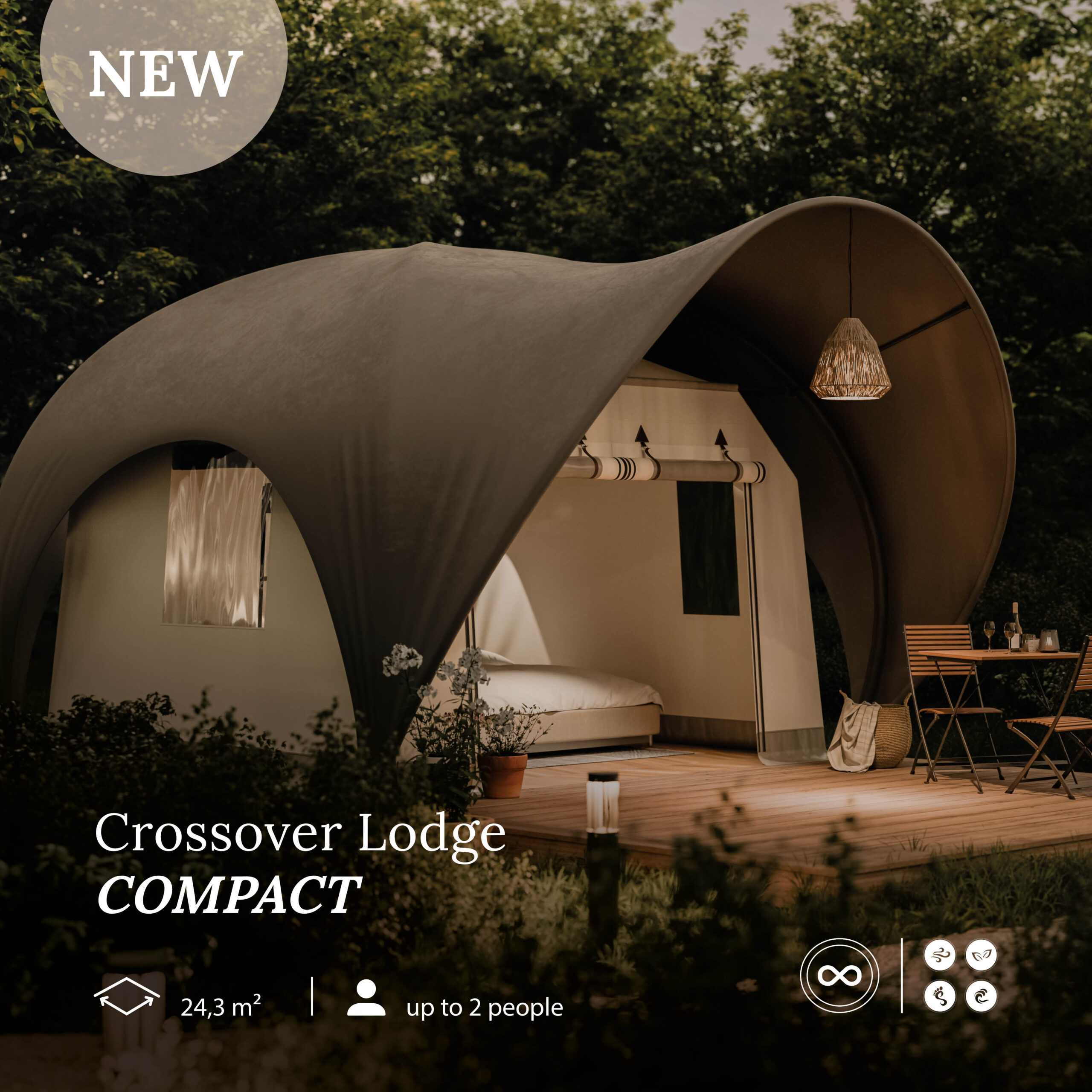Table of contents
- Introduction: Why glamping is booming
- Location: The heart of your glamping business
- Legal requirements: Permits and regulations
- Infrastructure: What you need on site
- Concept and accommodation types
- Target audience: Who will stay with you?
- Trends in glamping and sustainable tourism
- Market research & competitor analysis
- Costs: Fixed, variable, and what to expect
- Conclusion: How to build a glamping site that works
Introduction: why glamping is booming
Glamping — short for glamorous camping — is where the comfort of a boutique hotel meets the charm of the great outdoors. It’s no longer just a trend; it’s a lifestyle embraced by eco-minded travelers, couples craving something unique, and remote workers who’d rather log in surrounded by birdsong than traffic noise.
But how do you turn this growing movement into a successful business? It all starts with a clear vision… and a solid plan.
Location: the heart of your glamping business
Let’s talk land. Are you setting up locally, or dreaming about a spot abroad?
Buying land as a foreigner can be tricky, so always check with a local lawyer who knows the rules. Some countries allow foreign ownership, others don’t — and sometimes leasing or partnering up makes more sense.
What to keep in mind:
- Zoning & land use: Is the area classified as recreational or agricultural?
- Access: Can guests reach it easily by car or camper van?
- Utilities: Is water, electricity, sewage, or internet already available?
- Environmental constraints: Is the land protected? You might need special studies or permits.
💡 Pro tip: Glamping setups like tents or eco domes often fall under temporary structures, which gives you more flexibility in natural areas.
Legal requierements: permits and regulations
What permits do you need for starting a glamping business?
Before setting up any glamping tents, domes, or tiny homes, you’ll need permits. This usually includes:
- Permission to place lodges or tents
- Sanitary or bathroom installations
- Reception areas or communal kitchens
Even if your land is zoned for recreation, that doesn’t mean you’re automatically allowed to build. Always check with the local municipality first.
Talk to local authorities
- A clear “yes or no” on what’s possible
- Info on subsidies or local grants
- Environmental, safety, or building requirements
Permit overview by country
| 🌍 Country | ✅ Benefits | ⚠️ Permits & Legal Notes | 💡 Tips |
|---|---|---|---|
| 🇫🇷 France | Strong camping culture | “Permis d’aménager” required | Start small, partner with local mayors |
| 🇪🇸 Spain | Sunny climate | Regional rules, environmental studies | Hire local legal help |
| 🇮🇹 Italy | Agro-tourism friendly | Permit needed for each structure | Use agriturismo-zoned land |
| 🇺🇸 USA | Huge potential | Zoning + campground license | Choose favorable areas |
| 🇬🇷 Greece | Growing eco-tourism | EOT license mandatory | Focus on local products |
| 🇬🇧 UK | Staycation boom | Planning permission required | “Pop-up” camping possible |
| 🇿🇦 South Africa | Nature-rich landscapes | Land + environmental permits | Team up with game lodges |
| 🌏 SE Asia | Low startup costs | Land ownership restrictions | Consider leases or joint ventures |
| 🌍 Country | ✅ Benefits | ⚠️ Permits & Legal Notes | 💡 Tips |
|---|---|---|---|
| 🇫🇷 France | Strong camping culture | “Permis d’aménager” required | Start small, partner with local mayors |
| 🇪🇸 Spain | Sunny climate | Regional rules, environmental studies | Hire local legal help |
| 🇮🇹 Italy | Agro-tourism friendly | Permit needed for each structure | Use agriturismo-zoned land |
| 🇺🇸 USA | Huge potential | Zoning + campground license | Choose favorable areas |
| 🇬🇷 Greece | Growing eco-tourism | EOT license mandatory | Focus on local products |
| 🇬🇧 UK | Staycation boom | Planning permission required | “Pop-up” camping possible |
| 🇿🇦 South Africa | Nature-rich landscapes | Land + environmental permits | Team up with game lodges |
| 🌏 SE Asia | Low startup costs | Land ownership restrictions | Consider leases or joint ventures |
Infrastructure: what do you need on site
Check the infrastructure
- Accessibility: Are the roads decent? Is it reachable all year round?
- Utilities: If you’re missing power, water, or internet, be ready for extra setup costs.
- Sewerage: Septic tanks, eco-toilets, or composting options?
Permanent buildings aren’t always allowed in natural areas — but that’s where flexible options like the Crossover Lodge shine. Our structures are movable, foundation-free, and easier to get approved.
Plus, glamping fits right into the eco-tourism wave that’s sweeping across the globe.
Concept and accommodation types
| Accommodation Type | Pros | Cons |
|---|---|---|
| Safari Tents | Spacious, family-friendly | Less insulated |
| Glamping Domes | Futuristic design, well-insulated, suitable for all audiences | Can get hot |
| Tiny Houses | Fully equipped, usable year-round | Smaller |
| Treehouses | Unique, immersive in nature | Not always accessible |
| Yurts | Cozy, atmospheric | Thin walls = less privacy |
| Accommodation Type | Pros | Cons |
|---|---|---|
| Safari Tents | Spacious, family-friendly | Less insulated |
| Glamping Domes | Futuristic design, well-insulated, suitable for all audiences | Can get hot |
| Tiny Houses | Fully equipped, usable year-round | Smaller |
| Treehouses | Unique, immersive in nature | Not always accessible |
| Yurts | Cozy, atmospheric | Thin walls = less privacy |
Target audience: who will stay with you?
Step 1: start with your vision
- Luxe or low-key?
- Quiet retreat or family-friendly fun?
- Do you want daily contact with guests, or more of a hands-off approach?
Step 2: understand your audience
| Audience | Characteristics | What They Seek |
|---|---|---|
| Couples (25–45) | Trendy, eco-conscious, often no kids | Peace, nature, unique design, Instagram-worthy |
| Families with Kids | Safety, comfort, space | Toilets, small pool, animals, playground |
| Millennials / Digital Nomads | Flexible, love off-season travel | Wi-Fi, good food, community vibes |
| Wellness Seekers / Retreats | Yoga, silence, self-care | Eco-lux domes, hot tubs, meditation |
| Hikers / Active Travelers | Minimalist, adventurous | Sustainable, basic but comfy, near trails |
| Seniors (55+) | Comfort, good beds, quiet | No fuss, cultural offerings, outside school holidays |
| Groups / Friends | Social, want connection + space | Multiple units + shared space for gatherings |
| Audience | Characteristics | What They Seek |
|---|---|---|
| Couples (25–45) | Trendy, eco-conscious, often no kids | Peace, nature, unique design, Instagram-worthy |
| Families with Kids | Safety, comfort, space | Toilets, small pool, animals, playground |
| Millennials / Digital Nomads | Flexible, love off-season travel | Wi-Fi, good food, community vibes |
| Wellness Seekers / Retreats | Yoga, silence, self-care | Eco-lux domes, hot tubs, meditation |
| Hikers / Active Travelers | Minimalist, adventurous | Sustainable, basic but comfy, near trails |
| Seniors (55+) | Comfort, good beds, quiet | No fuss, cultural offerings, outside school holidays |
| Groups / Friends | Social, want connection + space | Multiple units + shared space for gatherings |
Step 3: Match them to your location
- Mountains? Think yoga retreats and hikers.
- Beachfront? Perfect for couples and families.
- Farm life? Great for kids and agro-tourists.
- Island or forest hideaway? Ideal for digital nomads and off-grid seekers.
Step 4: run target group tests
- How much would they pay?
- What does “glamping” mean to them?
- Where would they book — Instagram? Booking.com? Word-of-mouth?
- Would you book your own site if you were them?
Market research & competitor analysis
Before building your dream glamping site, take a look around. Is there a local demand for unique outdoor stays?
Research existing glamping spots nearby. What do they offer? How much do they charge? What stands out — and where do they fall short?
Review guest feedback to see what people love (and what they miss). It’s pure gold when shaping your own concept.
Also, keep an eye on broader trends. Guests today crave:
- Unique stays close to nature
- Off-grid escapes for digital detoxes
- High-end comfort in wild locations
- Local food, culture, and experiences
Digital nomads are another fast-growing group. Give them WiFi, a desk, and peace — and they’re in. More travelers also want to reduce their footprint, so showing your commitment to sustainability and the local community gives you an edge.
Costs: fixed, variable, and what to expect
💰 Fixed Costs:
- Buying or leasing land
- Glamping tents or domes
- Infrastructure (roads, power, toilets)
- Branding and website
- Legal and permit costs
🔁 Variable Costs:
- Cleaning and maintenance
- Insurance and taxes
- Freelancers or part-time help
- Booking platform fees (Airbnb, Booking.com)
- Marketing and advertising
Financial planning & costs
| Item | Cost (€) | Notes |
|---|---|---|
| Land purchase | 327,000 | Excl. taxes |
| 2 Glamping tents | 71,200 | Fully furnished |
| Permits/advice | 5,000–10,000 | Local costs |
| Insurance | 2,500 | Annual |
| Solar power | 8,000–15,000 | Basic setup |
| Septic system | 6,000–10,000 | For 2 units |
| Parking access | 3,000–5,000 | Gravel road |
| Website/booking | 1,000–2,000 | Platform setup |
| Contingency | 5,000–10,000 | Always plan extra |
| Total Estimate: | €428,700 – €452,700 | |
Use the Crossover Lodge ROI Calculator to calculate your ROI.
| Item | Cost (€) | Notes |
|---|---|---|
| Land purchase | 327,000 | Excl. taxes |
| 2 Glamping tents | 71,200 | Fully furnished |
| Permits/advice | 5,000–10,000 | Local costs |
| Insurance | 2,500 | Annual |
| Solar power | 8,000–15,000 | Basic setup |
| Septic system | 6,000–10,000 | For 2 units |
| Parking access | 3,000–5,000 | Gravel road |
| Website/booking | 1,000–2,000 | Platform setup |
| Contingency | 5,000–10,000 | Always plan extra |
| Total estimate | €428,700 – €452,700 | |
Use the Crossover Lodge ROI Calculator to forecast your earnings.
Conclusion
Now you’ve got the roadmap to start your own glamping business — from choosing the right spot and audience to building a future-proof retreat.
Glamping is more than just pitching a fancy tent. It’s about crafting experiences, connecting with nature, and creating a space people can’t wait to return to.
So, what’s your glamping dream? And when will you start building it?












